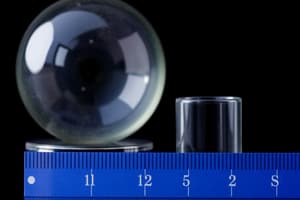Podcast
Questions and Answers
What type of bonding primarily holds simple covalent molecules together?
What type of bonding primarily holds simple covalent molecules together?
- Metallic bonds
- Ionic bonds
- Weak intermolecular forces
- Strong covalent bonds (correct)
Which of the following statements about simple covalent substances is true?
Which of the following statements about simple covalent substances is true?
- They evaporate easily due to low intermolecular forces. (correct)
- They have high melting and boiling points.
- They are generally good conductors of electricity.
- Most are soluble in water.
How does the length of molecules affect their melting and boiling points?
How does the length of molecules affect their melting and boiling points?
- Longer molecules lower the melting and boiling points.
- Longer molecules increase the melting and boiling points. (correct)
- Longer molecules lead to decreased intermolecular forces.
- Molecule length has no effect on these points.
What is a primary characteristic of alloys compared to pure metals?
What is a primary characteristic of alloys compared to pure metals?
Which of the following best describes the conductivity of simple covalent substances?
Which of the following best describes the conductivity of simple covalent substances?
Which statement about pure metals is accurate?
Which statement about pure metals is accurate?
What is one unique property of ammonia among simple covalent substances?
What is one unique property of ammonia among simple covalent substances?
What is a consequence of the presence of valence electrons in metal atoms?
What is a consequence of the presence of valence electrons in metal atoms?
Which of the following substances would generally have the highest volatility?
Which of the following substances would generally have the highest volatility?
What happens to the properties of pure metals when they are turned into alloys?
What happens to the properties of pure metals when they are turned into alloys?
Flashcards are hidden until you start studying
Study Notes
Physical Quantities and Measurements
- Time: Measured in seconds (s), common unit includes minutes.
- Temperature: Measured in Kelvin (K), degrees Celsius (°C) is also commonly used.
- Length: Measured in meters (m) with common units of centimeters (cm), kilometers (km), and feet.
- Mass: Measured in kilograms (kg), with grams (g) and tonnes (t) as common alternatives.
- Volume: Measured in cubic meters (m³), liters, or cubic centimeters (cm³).
Measuring Instruments
- Digital Stopwatch: Accurate timing up to 10 seconds or more.
- Pipette: Fixed volume measurements (e.g., 10-0 cm³, 25.0 cm³).
- Volumetric Flask: Used for precise larger fixed volume measurements (e.g., 100 cm³, 250 cm³).
- Measuring Cylinder: Measures volumes with a precision of up to 0.5 cm³ (e.g., 31.5 cm³, 230 cm³).
- Burette: Measures volumes with a precision of 0.05 cm³ (e.g., 31.55 cm³, 23.00 cm³).
- Gas Syringe: Measures volumes of gas, typically up to 100 cm³.
Gas Collection and Separation Techniques
- Gases can be collected based on their solubility and density compared to surrounding air.
- Solid-Solid Separation: Techniques include magnetic attraction and sieving for different particle sizes.
- Solid-Liquid Separation: Utilizes filtration, allowing insoluble solids to be separated from liquids.
- Evaporation: Removes solvents to retrieve dissolved solids (e.g., obtaining salt from seawater).
- Crystallization: Produces pure solids from saturated solutions.
- Simple Distillation: Separates liquids with different boiling points (e.g., water from saltwater).
- Fractional Distillation: Used for miscible liquids (e.g., ethanol and water) based on boiling point differences.
- Chromatography: Separates substances based on solubility in a solvent, creating a chromatogram.
Purity Determination
- Pure Substances: Have specific melting/boiling points; mixtures melt/boil over ranges.
- Effect of Impurities: Changing boiling points depending on substances added (e.g., salt in water).
States of Matter
- Kinetic Particle Theory: Matter consists of tiny particles in constant motion.
- Solids: Fixed shape/volume, closely packed particles that vibrate.
- Liquids: Fixed volume but unfixed shape, particles slide past each other.
- Gases: Unfixed shape/volume, widely spaced particles that move randomly.
Phase Transitions
- Melting: Solid to liquid transition with thermal energy conversion.
- Freezing: Liquid to solid transition as kinetic energy is lost.
- Evaporation and Boiling: Liquids turn into gas by gaining energy.
- Condensation: Gases lose energy to become liquids.
- Sublimation: Solid directly transitions to gas (e.g., dry ice).
- Vapor Deposition: Gaseous to solid transition, forming substances like snow.
Matter Composition
- Matter consists of atoms; smaller than particles and combine to form molecules.
- Subatomic Particles: Nucleus contains protons and neutrons; electrons orbit around the nucleus.
Elements, Compounds, and Mixtures
- Elements: Pure substances that cannot be chemically broken down; exist as atoms or molecules.
- Compounds: Combinations of elements in fixed ratios, separable by chemical means.
- Mixtures: Physical combinations of substances without fixed proportions; separable through physical methods.
Properties of Ionic Substances
- Ionic compounds form giant crystal lattice structures with high melting/boiling points.
- Hard but brittle due to strong electrostatic forces between oppositely charged ions.
- Conduct electricity when melted or dissolved in water, but not in solid state.
Properties of Covalent Substances
- Covalent substances consist of molecules with strong bonds but weak intermolecular forces.
- Often gases or liquids at room temperature with low melting/boiling points; some soluble in organic solvents.
- Do not conduct electricity.
Properties of Metals and Alloys
- Alloys are mixtures that are generally stronger than pure metals.
- Metals possess a regular atomic structure, making them malleable and ductile.
- Metals and alloys have high conductivity for heat and electricity due to mobile valence electrons.
Studying That Suits You
Use AI to generate personalized quizzes and flashcards to suit your learning preferences.




